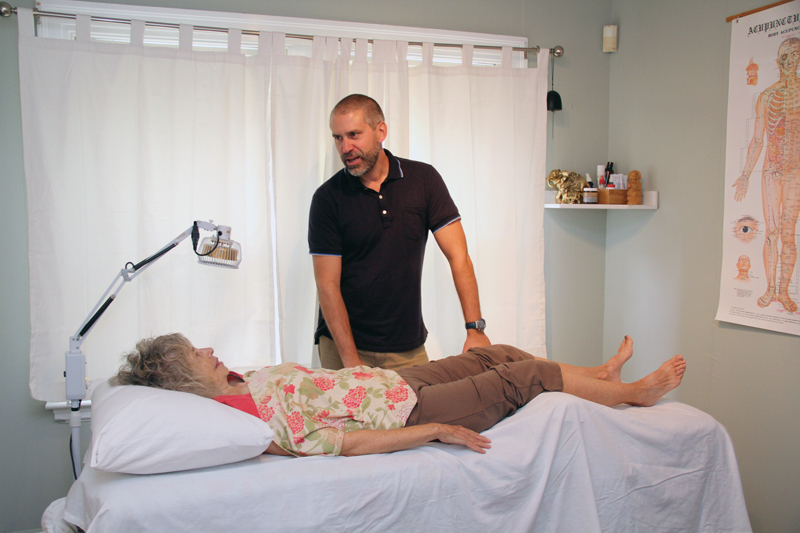You’ve been eating so well. You’ve been exercising. You’re losing weight, you’re feeling more energetic, your clothes are fitting better. Just look in that mirror – what a fine specimen you are!
But…
You still have a bit of that gut, huh? Oh, it’s definitely decreased. Like maybe there’s an orange in there now instead of a cantaloupe. And it’s not flab – you can barely pinch an inch. But whatever it is, you want it gone.
So, what gives? Why does it feel like there’s literally something physical inside preventing you from attaining that nice flat belly you so deserve? Well, from an acupuncturist’s perspective, your “belt” is too tight. Your “belt” meridian that is. The actual term for this acupuncture channel is the Dai Mai, but it roughly translates to the “belt” meridian in English.
The Dai Mai is one of eight unique acupuncture channels called the “Extraordinary Vessels.” The Extraordinary Vessels are highly susceptible to psycho-emotional stress and trauma. You’ve heard of traumatic experiences literally getting “stuck” in our bodies, right? Well the Extraordinary Vessels are prime targets for that stuck-ness to occur. And the Dai Mai happens to be especially vulnerable, perhaps because it is the only acupuncture channel that runs horizontally, roughly following the circumference of the diaphragm.
When stress affects the Dai Mai, the meridian essentially tightens. Think about it – when you’re stressed, what’s one of the first things you notice if you check in with your body? You’re probably not breathing very deeply, are you? The smooth, rhythmic motion of the diaphragm isn’t so smooth and rhythmic under stress. Feels kind of tight around that “belt,” doesn’t it?
And unfortunately, as that constriction occurs, the underlying organs are affected.
[Just a note before we go on: when we speak of organs in Traditional Chinese Medicine (TCM), we always need to stress that we’re talking about them more conceptually than literally. In TCM the organs are thought of as an energetic system or circuit with multiple jobs and functions relative to the entire body. If we say there’s an issue with your Liver, it doesn’t mean you need a transplant or even that your liver enzymes would show as elevated on a blood test.]
The main culprit when dealing with Dai Mai constriction is the Liver. In TCM, the Liver is responsible for ensuring the smooth flow of qi through our bodies, including the gastrointestinal tract. When the Liver is stressed, that smooth flow gets choppy. I always envision a cartoon engine, humming along nicely when all of a sudden a monkey wrench gets thrown into it. The engine clunks and sputters, turns red, and starts to expand. There’s a buildup of friction, which causes heat, which causes expansion. This is an apt metaphor for what happens when the Liver is constricted by the Dai Mai.
As the Liver “expands,” it encroaches on s nearest neighbors – the Spleen and Stomach. These organs are considered the main organs of digestion in TCM, a yin/yang pair that is responsible for extracting the vital nutrients from our food and sending the rest down the pipes. When the Liver is crowding the Spleen and Stomach, they can’t do their jobs very well. Digestion slows. Now, not only is the engine not running smoothly, it’s getting clogged with gunk as well. It’s a vicious cycle.
So, what can be done? There’s one particular acupuncture point that acts as a sort of release valve for the Dai Mai. And believe it or not, that point is on your foot. Now, while acupuncture is the best way to release the Dai Mai, let’s not make the perfect the enemy of the good – you can personally address a dysfunctional Dai Mai with some acupressure. The acupuncture point we want to work on is called GB-41 (you can Google it for a visual reference – fun fact: it’s labeled “GB” because it’s on the Gallbladder Meridian).
Here’s how to find GB-41: put your finger where your two smallest toes meet the top of your foot. Now flex your toes up and start to slide your finger back toward your ankle while staying in the groove between the bones. In about an inch, your finger will slide over a tendon and plop down towards the outside edge of your foot into a little divot. Congratulations – you’ve found GB-41!
There are many DIY techniques for working on this point, but you just need to do something that brings your focus and attention to it. Even just massaging it in small circular motions will get the job done. For more information on DIY techniques, along with more health issues for which to use them, download my free E-Book Go Poke Yourself from our website at www.CTfamilyacupuncture.com.
At its core, the goal of acupuncture is to generate motion. When things are blocked, clogged, stuck or stagnant, dysfunction and discomfort are the result. And the Dai Mai is certainly no exception to this rule. Luckily, with acupuncture and TCM we have the tools to get circulation in the Dai Mai humming along smoothly again. Let’s unbuckle that belt a few notches, shall we?
Matt Maneggia is a licensed acupuncturist and the founder of Connecticut Family Acupuncture with offices in Coventry, Glastonbury and West Hartford. As a board member of the CT Society of Acupuncturists, Matt advocates for increased access to acupuncture through insurance coverage and integration of acupuncture into the mainstream healthcare system. He can be contacted through his website at: www.CTfamilyacupuncture.com or via the main office at 860-503-3676.
